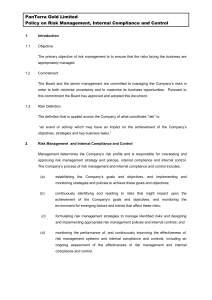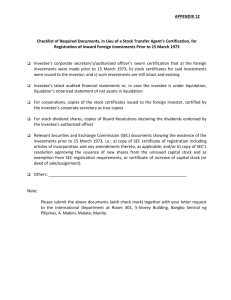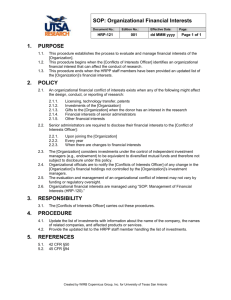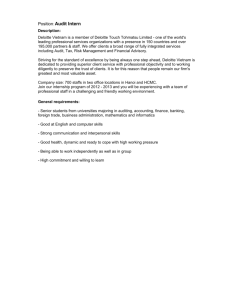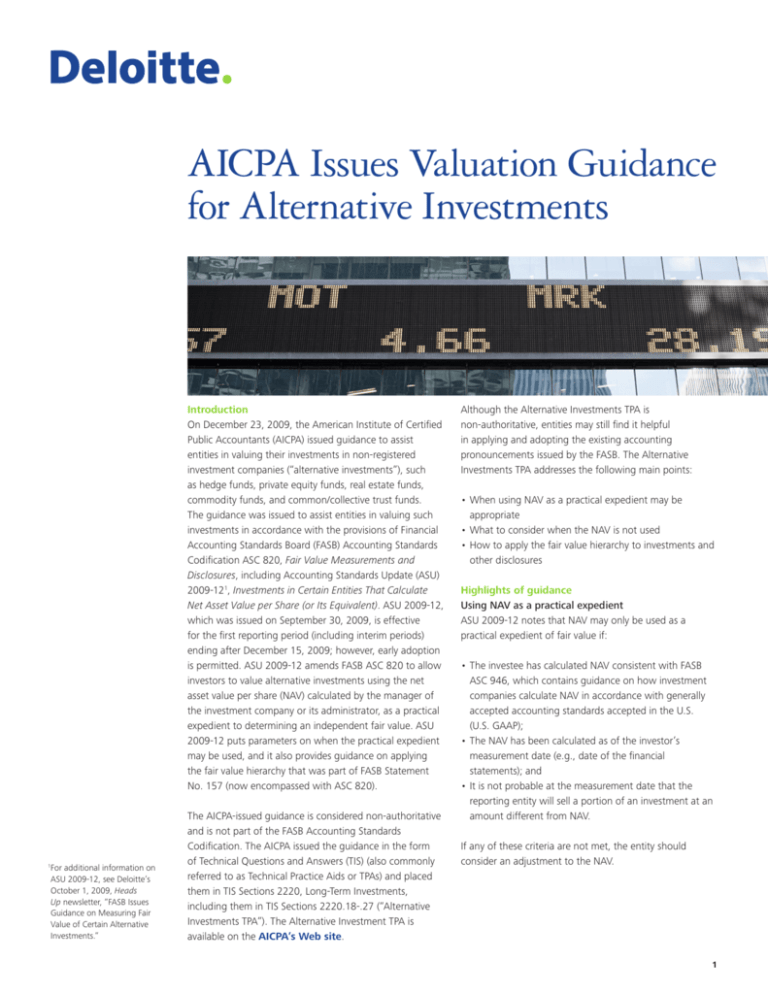
AICPA Issues Valuation Guidance
for Alternative Investments
Introduction
On December 23, 2009, the American Institute of Certified
Public Accountants (AICPA) issued guidance to assist
entities in valuing their investments in non-registered
investment companies (“alternative investments”), such
as hedge funds, private equity funds, real estate funds,
commodity funds, and common/collective trust funds.
The guidance was issued to assist entities in valuing such
investments in accordance with the provisions of Financial
Accounting Standards Board (FASB) Accounting Standards
Codification ASC 820, Fair Value Measurements and
Disclosures, including Accounting Standards Update (ASU)
2009-121, Investments in Certain Entities That Calculate
Net Asset Value per Share (or Its Equivalent). ASU 2009-12,
which was issued on September 30, 2009, is effective
for the first reporting period (including interim periods)
ending after December 15, 2009; however, early adoption
is permitted. ASU 2009-12 amends FASB ASC 820 to allow
investors to value alternative investments using the net
asset value per share (NAV) calculated by the manager of
the investment company or its administrator, as a practical
expedient to determining an independent fair value. ASU
2009-12 puts parameters on when the practical expedient
may be used, and it also provides guidance on applying
the fair value hierarchy that was part of FASB Statement
No. 157 (now encompassed with ASC 820).
For additional information on
ASU 2009-12, see Deloitte’s
October 1, 2009, Heads
Up newsletter, “FASB Issues
Guidance on Measuring Fair
Value of Certain Alternative
Investments.”
1
The AICPA-issued guidance is considered non-authoritative
and is not part of the FASB Accounting Standards
Codification. The AICPA issued the guidance in the form
of Technical Questions and Answers (TIS) (also commonly
referred to as Technical Practice Aids or TPAs) and placed
them in TIS Sections 2220, Long-Term Investments,
including them in TIS Sections 2220.18-.27 (“Alternative
Investments TPA”). The Alternative Investment TPA is
available on the AICPA’s Web site.
Although the Alternative Investments TPA is
non-authoritative, entities may still find it helpful
in applying and adopting the existing accounting
pronouncements issued by the FASB. The Alternative
Investments TPA addresses the following main points:
•When using NAV as a practical expedient may be
appropriate
•What to consider when the NAV is not used
•How to apply the fair value hierarchy to investments and
other disclosures
Highlights of guidance
Using NAV as a practical expedient
ASU 2009-12 notes that NAV may only be used as a
practical expedient of fair value if:
•The investee has calculated NAV consistent with FASB
ASC 946, which contains guidance on how investment
companies calculate NAV in accordance with generally
accepted accounting standards accepted in the U.S.
(U.S. GAAP);
•The NAV has been calculated as of the investor’s
measurement date (e.g., date of the financial
statements); and
•It is not probable at the measurement date that the
reporting entity will sell a portion of an investment at an
amount different from NAV.
If any of these criteria are not met, the entity should
consider an adjustment to the NAV.
1
The Alternative Investments TPA suggests that the
reporting entity’s management should independently
evaluate the fair value measurement process utilized by the
alternative investment manager to calculate NAV in order
to determine consistency with ASC 946. Many investors
already consider this as part of their initial and ongoing
due diligence process. The Alternative Investments TPA
is noteworthy in that it focuses heavily on the need to
evaluate the adequacy of the financial reporting processes
and controls used to estimate fair value that exist at
the underlying fund manager (or its administrator) and
suggests that investors should understand and evaluate
changes in such processes and controls. It provides specific
points that investors may want to make sure that they
address and document, including the following:
•The portion of the underlying securities held by the
investee fund that are traded on active markets
•The professional reputation and standing of the investee
fund’s auditor and any qualification of its report
•Whether there is a history of significant adjustments to the
NAV reported by the investee fund manager as a result of
the annual financial statement audit or otherwise
•Findings in the investee fund’s advisor or administrator’s
SAS 70 report, if any
•Whether NAV has been appropriately adjusted for items
such as carried interest and clawbacks
•Comparison of historical realizations to last reported fair
value
The Alternative Investment TPA notes that an investor in a
fund of funds should evaluate the controls and processes
at the fund of funds manager and would not necessarily
be required to look through to the processes and controls
at the underlying fund interests of the fund of funds.
Considerations when the NAV is not used
When the practical expedient is not available or when an
entity elects not to use it, an entity will need to estimate
the fair value of the alternative investment. When the
NAV is of a date other than the entity’s measurement
date, the Alternative Investments TPA suggests that an
entity perform a rollforward from the date of the NAV
considering capital activity and changes in valuations.
The Alternative Investments TPA notes that, in some
instances, an entity may be able to obtain sufficient
information from the alternative investment manager to
estimate an adjustment to a provided NAV that was not
in accordance with U.S. GAAP. However, depending on
the availability of valuation information, transparency, and
unique characteristics of the alternative investments, the
task of determining the fair value of such investments may
pose challenges and will likely require significant effort to
estimate fair value for these alternative investments that do
not have readily determinable fair values.
The Alternative Investment TPA offers examples of inputs
that might be used when estimating and adjusting fair
values, and reminds entities that methods used to measure
the fair value of an investment should reflect assumptions
that a market participant would use to value the asset
based on the best information available. Example inputs
include NAV, observed transactions including level and
volume of activity, expected future cash flows, features of
the alternative investment, and its investment performance
relative to benchmarks/indices and other comparable
investments. Each individual feature would need to
be assessed for its potential impact on fair value. The
inclusion of these considerations suggests that demand
for an alternative investment may be higher (lower)
than comparable investments because certain elements
are more (less) attractive than on such comparable
investments, causing an investor to be willing to pay
more (less) than the NAV of such alternative investment.
The Alternative Investments TPA does note that, after
evaluating these elements, an entity may conclude that the
NAV is the best measure of fair value.
2
In evaluating features, the Alternative Investments
TPA draws a distinction between Initial Due Diligence
Features, which represent features that are inherent to
the specific alternative investment (such as restrictions
on redemption outlined in the offering memorandum)
which where contemplated (and accepted) when making
the initial investment, and Ongoing Monitoring Features,
which represent features related to activities post initial
investment, including the triggering of key provisions in
the governing documents. The table below highlights
some of the key features.
Initial Due Diligence Features
Ongoing Monitoring Features
Initial lock-up periods and redemption fees
Significant changes in key terms of the
investee fund
Notice periods for redemption requests
Observed material redemptions from an
investee fund
Holdback amounts on redemptions
Notification of redemption triggers the
assessment of redemption fee
Suspension of redemptions (i.e., gate
provisions)
Imposition of a gate
Lack of redemption option
Closure of fund to new subscriptions
Required fund sponsor approval to transfer
interests
Ability of fund to identify and make
acceptable investments
Use of Designated Accounts or Side
Pockets for illiquid investments
Allegations of fraud against the investee
fund manager
Change in financial strength or key
personnel of investment manager
As it relates to Initial Due Diligence Features, the presence
of such features by themselves may not require an
adjustment to NAV as they may represent common
features of similar investment products offered in the
marketplace and/or have been accepted by investors at
the initial acquisition as not being a significant deterrent or
adjustment factor to initial NAV. For example, the presence
of gate provisions, or the contractually allowable use by
the alternative investment manager of Side Pockets, may
not have any impact on NAV over the holding period
unless those provisions are exercised by the manager.
The reporting entity should also consider key Initial Due
Diligence Features in the alternative investment relative
to those prevailing in the current market; terms that are
more restrictive than those observed in the marketplace for
similar alternative investments may suggest a discount and
vice versa.
provision may be indicative of liquidity concerns with the
underlying investments and also result in liquidity concerns
with respect to alternative investment as a whole, as a
gate provision will likely increase the timing of redemption
receipt. Such are features that a market participant is likely
to consider and may result in a discount to the investment
value. The magnitude of the discount is a matter of
professional judgment. In general, an investor should
consciously evaluate how changes from the Initial Due
Diligence features may impact an alternative investment’s
fair value when an entity is not using or is not able to use
NAV as a practical expedient.
Disclosures
ASU 2009-12 suggests that if the reporting entity does
not have the ability to redeem its investment at NAV (e.g.,
it has the contractual and practical ability to redeem) in
the “near term” at the measurement date, the investment
should be classified as level 3 in the fair value hierarchy.
The Alternative Investment TPA clarifies two points:
1)In order for an investment in a redeemable alternative
investment to meet the criteria for level 2 classification
within the fair value hierarchy, the reporting entity need
not have submitted a previous redemption request
effective as of the measurement date.
2)A redemption period of 90 days or less would generally
be considered “near term,” although other factors may
be relevant and should be considered.
The fair value hierarchy is required to be shown for major
categories of investments, and investors have questioned
how that should be shown for alternative investments. The
Alternative Investments TPA clarifies that major categories
disclosed for alternative investments should be tailored
to the specific nature and risks of the reporting entity’s
alternative investments. In the absence of a diversified
portfolio of alternative investments (i.e., hedge, private
equity, venture, real estate, etc.), the reporting entity
may consider more specific categories such as industry,
geography, strategy, etc., which allow readers to further
understand the risks and exposures associated with the
alternative investment categories.
In general, entities should remember that changes in how an
entity values its alternative investments may trigger additional
disclosure requirements if significant. Additional guidance on
this subject may be forthcoming from the AICPA.
On the other hand, Ongoing Monitoring Features, which
result in a significant change from conditions at the initial
due diligence date, are more likely to result in fair value
adjustments. To illustrate, the actual imposition of a gate
3
Contacts
For more information, please contact:
Rajan Chari
Partner
Deloitte & Touche LLP
rchari@deloitte.com
+ 1 312 486 4845
Robert Fabio
Partner
Deloitte & Touche LLP
rfabio@deloitte.com
+1 212 436 5492
Brian Gallagher
Partner
Deloitte & Touche LLP
bgallagher@deloitte.com
+1 617 437 2398
Jose Sarabia
Senior Manager
Deloitte & Touche LLP
jsarabia@deloitte.com
+ 1 213 996 6330
About Deloitte
Deloitte refers to one or more of Deloitte Touche Tohmatsu, a Swiss Verein, and its network of member firms,
each of which is a legally separate and independent entity. Please see www.deloitte.com/about for a detailed
description of the legal structure of Deloitte Touche Tohmatsu and its member firms. Please see www.deloitte.
com/us/about for a detailed description of the legal structure of Deloitte LLP and its subsidiaries.
Copyright © 2010 Deloitte Development LLC. All rights reserved.
Member of Deloitte Touche Tohmatsu
4

